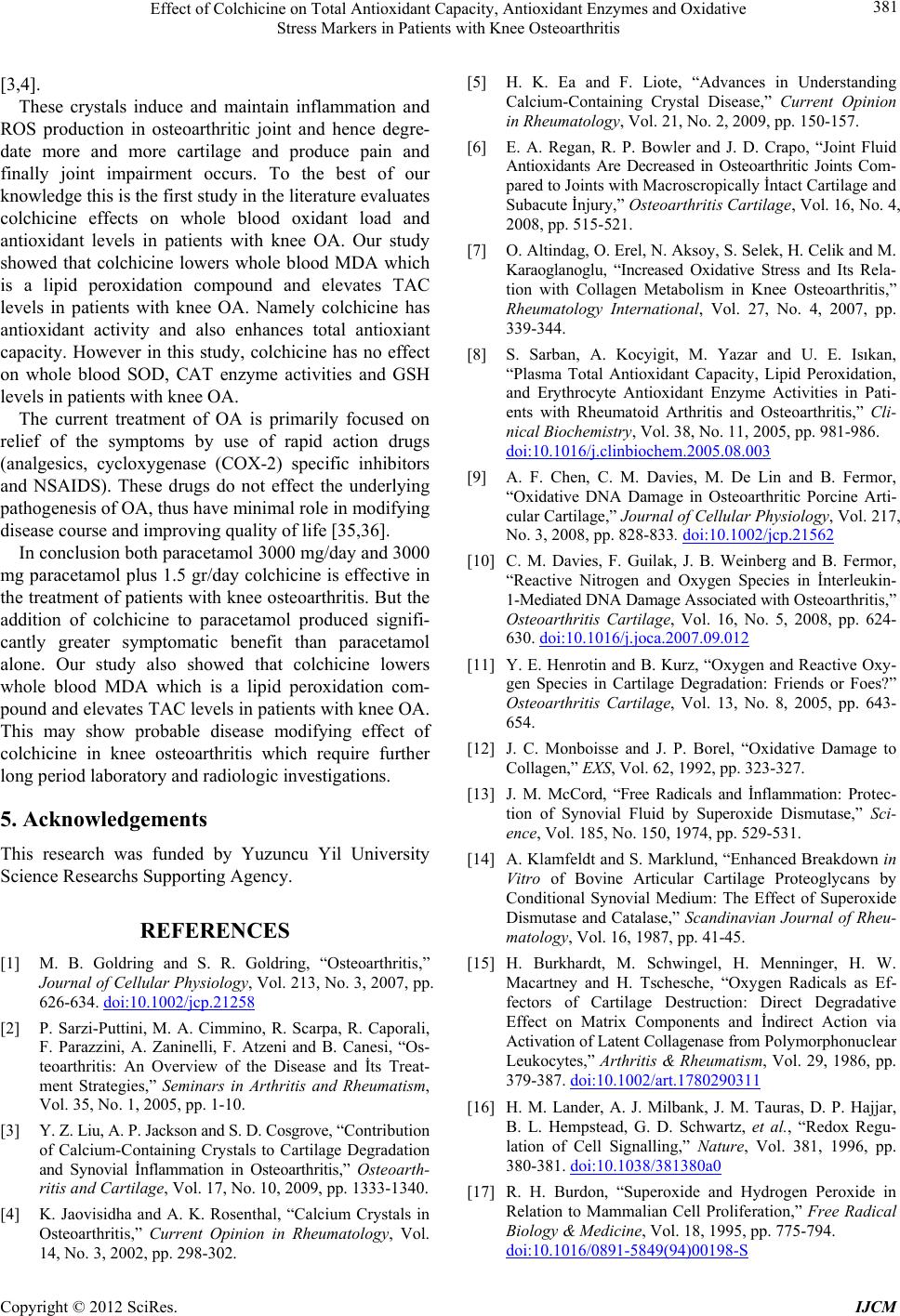
Effect of Colchicine on Total Antioxidant Capacity, Antioxidant Enzymes and Oxidative
Stress Markers in Patients with Knee Osteoarthritis
381
[3,4].
These crystals induce and maintain inflammation and
ROS production in osteoarthritic joint and hence degre-
date more and more cartilage and produce pain and
finally joint impairment occurs. To the best of our
knowledge this is the first study in the literature evaluates
colchicine effects on whole blood oxidant load and
antioxidant levels in patients with knee OA. Our study
showed that colchicine lowers whole blood MDA which
is a lipid peroxidation compound and elevates TAC
levels in patients with knee OA. Namely colchicine has
antioxidant activity and also enhances total antioxiant
capacity. However in this study, colchicine has no effect
on whole blood SOD, CAT enzyme activities and GSH
levels in patients with knee OA.
The current treatment of OA is primarily focused on
relief of the symptoms by use of rapid action drugs
(analgesics, cycloxygenase (COX-2) specific inhibitors
and NSAIDS). These drugs do not effect the underlying
pathogenesis of OA, thus have minimal role in modifying
disease course and improving quality of life [35,36].
In conclusion both paracetamol 3000 mg/day and 3000
mg paracetamol plus 1.5 gr/day colchicine is effective in
the treatment of patients with knee osteoarthritis. But the
addition of colchicine to paracetamol produced signifi-
cantly greater symptomatic benefit than paracetamol
alone. Our study also showed that colchicine lowers
whole blood MDA which is a lipid peroxidation com-
pound and elevates TAC levels in patients with knee OA.
This may show probable disease modifying effect of
colchicine in knee osteoarthritis which require further
long period laboratory and radiologic investigations.
5. Acknowledgements
This research was funded by Yuzuncu Yil University
Science Researchs Supporting Agency.
REFERENCES
[1] M. B. Goldring and S. R. Goldring, “Osteoarthritis,”
Journal of Cellular Physiology, Vol. 213, No. 3, 2007, pp.
626-634. doi:10.1002/jcp.21258
[2] P. Sarzi-Puttini, M. A. Cimmino, R. Scarpa, R. Caporali,
F. Parazzini, A. Zaninelli, F. Atzeni and B. Canesi, “Os-
teoarthritis: An Overview of the Disease and İts Treat-
ment Strategies,” Seminars in Arthritis and Rheumatism,
Vol. 35, No. 1, 2005, pp. 1-10.
[3] Y. Z. Liu, A. P. Jackson and S. D. Cosgrove, “Contribution
of Calcium-Containing Crystals to Cartilage Degradation
and Synovial İnflammation in Osteoarthritis,” Osteoarth-
ritis and Cartilage, Vol. 17, No. 10, 2009, pp. 1333-1340.
[4] K. Jaovisidha and A. K. Rosenthal, “Calcium Crystals in
Osteoarthritis,” Current Opinion in Rheumatology, Vol.
14, No. 3, 2002, pp. 298-302.
[5] H. K. Ea and F. Liote, “Advances in Understanding
Calcium-Containing Crystal Disease,” Current Opinion
in Rheumatology, Vol. 21, No. 2, 2009, pp. 150-157.
[6] E. A. Regan, R. P. Bowler and J. D. Crapo, “Joint Fluid
Antioxidants Are Decreased in Osteoarthritic Joints Com-
pared to Joints with Macroscropically İntact Cartilage and
Subacute İnjury,” Osteoarthritis Cartilage, Vol. 16, No. 4,
2008, pp. 515-521.
[7] O. Altindag, O. Erel, N. Aksoy, S. Selek, H. Celik and M.
Karaoglanoglu, “Increased Oxidative Stress and Its Rela-
tion with Collagen Metabolism in Knee Osteoarthritis,”
Rheumatology International, Vol. 27, No. 4, 2007, pp.
339-344.
[8] S. Sarban, A. Kocyigit, M. Yazar and U. E. Isıkan,
“Plasma Total Antioxidant Capacity, Lipid Peroxidation,
and Erythrocyte Antioxidant Enzyme Activities in Pati-
ents with Rheumatoid Arthritis and Osteoarthritis,” Cli-
nical Biochemistry, Vol. 38, No. 11, 2005, pp. 981-986.
doi:10.1016/j.clinbiochem.2005.08.003
[9] A. F. Chen, C. M. Davies, M. De Lin and B. Fermor,
“Oxidative DNA Damage in Osteoarthritic Porcine Arti-
cular Cartilage,” Journal of Cellular Physiology, Vol. 217,
No. 3, 2008, pp. 828-833. doi:10.1002/jcp.21562
[10] C. M. Davies, F. Guilak, J. B. Weinberg and B. Fermor,
“Reactive Nitrogen and Oxygen Species in İnterleukin-
1-Mediated DNA Damage Associated with Osteoarthritis,”
Osteoarthritis Cartilage, Vol. 16, No. 5, 2008, pp. 624-
630. doi:10.1016/j.joca.2007.09.012
[11] Y. E. Henrotin and B. Kurz, “Oxygen and Reactive Oxy-
gen Species in Cartilage Degradation: Friends or Foes?”
Osteoarthritis Cartilage, Vol. 13, No. 8, 2005, pp. 643-
654.
[12] J. C. Monboisse and J. P. Borel, “Oxidative Damage to
Collagen,” EXS, Vol. 62, 1992, pp. 323-327.
[13] J. M. McCord, “Free Radicals and İnflammation: Protec-
tion of Synovial Fluid by Superoxide Dismutase,” Sci-
ence, Vol. 185, No. 150, 1974, pp. 529-531.
[14] A. Klamfeldt and S. Marklund, “Enhanced Breakdown in
Vitro of Bovine Articular Cartilage Proteoglycans by
Conditional Synovial Medium: The Effect of Superoxide
Dismutase and Catalase,” Scandinavian Journal of Rheu-
matology, Vol. 16, 1987, pp. 41-45.
[15] H. Burkhardt, M. Schwingel, H. Menninger, H. W.
Macartney and H. Tschesche, “Oxygen Radicals as Ef-
fectors of Cartilage Destruction: Direct Degradative
Effect on Matrix Components and İndirect Action via
Activation of Latent Collagenase from Polymorphonuclear
Leukocytes,” Arthritis & Rheumatism, Vol. 29, 1986, pp.
379-387. doi:10.1002/art.1780290311
[16] H. M. Lander, A. J. Milbank, J. M. Tauras, D. P. Hajjar,
B. L. Hempstead, G. D. Schwartz, et al., “Redox Regu-
lation of Cell Signalling,” Nature, Vol. 381, 1996, pp.
380-381. doi:10.1038/381380a0
[17] R. H. Burdon, “Superoxide and Hydrogen Peroxide in
Relation to Mammalian Cell Proliferation,” Free Radical
Biology & Medicine, Vol. 18, 1995, pp. 775-794.
doi:10.1016/0891-5849(94)00198-S
Copyright © 2012 SciRes. IJCM